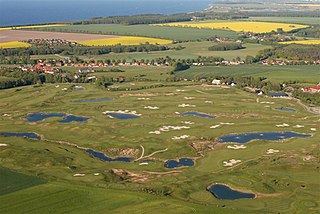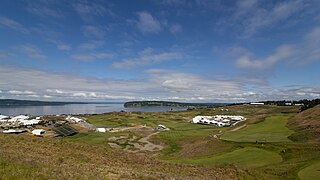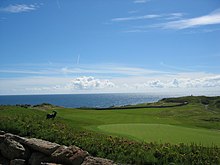
A golf course is the grounds on which the sport of golf is played. It consists of a series of holes, each consisting of a tee box, a fairway, the rough and other hazards, and a green with a cylindrical hole in the ground, known as a "cup". The cup holds a flagstick, known as a "pin". A standard round of golf consists of 18 holes, and as such most courses contain 18 distinct holes; however, there are many 9-hole courses and some that have holes with shared fairways or greens. There are also courses with a non-standard number of holes, such as 12 or 14.

Whistling Straits is one of two 36-hole links-style golf courses associated with Destination Kohler, a luxury golf resort owned and operated by the Kohler Company in Kohler, Wisconsin. The other course is Blackwolf Run, located in the Village of Kohler. The Whistling Straits complex is located north of Sheboygan, in the unincorporated community of Haven in the Town of Mosel in Sheboygan County. Whistling Straits is separated into two courses, the Straits Course and the Irish Course.
The following is a glossary of the terminology currently used in the sport of golf. Where words in a sentence are also defined elsewhere in this article, they appear in italics. Old names for clubs can be found at Obsolete golf clubs.

The men's major golf championships, commonly known as the major championships, and often referred to simply as the majors, are the most prestigious tournaments in golf. Historically, the national open and amateur championships of Great Britain and the United States were regarded as the majors. With the rise of professional golf in the middle of the twentieth century, the majors came to refer to the most prestigious professional tournaments.

Pinehurst Resort is a golf resort in Pinehurst, North Carolina, United States. It has hosted a number of prestigious golf tournaments including three U.S. Open Championships, one U.S. Women's Open, three U.S. Amateur Championships, one PGA Championship, and the Ryder Cup.

Harbour Town Golf Links is a public golf course in the eastern United States, located in South Carolina in Sea Pines Plantation on Hilton Head Island in Beaufort County. Since 1969, it has hosted the RBC Heritage on the PGA Tour, usually in mid-April, the week after The Masters.

A hazard is an area of a golf course in the sport of golf which provides a difficult obstacle, which may be of two types: (1) water hazards such as lakes and rivers; and (2) man-made hazards such as bunkers. The governing body for the game of golf outside the US and Canada, The R&A, say that A "hazard" is any bunker or water hazard. Special rules apply to play balls that fall in a hazard. For example, a player may not touch the ground with their club before playing a ball, not even for a practice swing. A ball in any hazard may be played as it lies without penalty. If it cannot be played from the hazard, the ball may be hit from another location, generally with a penalty of one stroke. The Rules of Golf govern exactly from where the ball may be played outside a hazard. Bunkers are shallow pits filled with sand and generally incorporating a raised lip or barrier, from which the ball is more difficult to play than from grass.
Turf management or pitchcare describes the work needed to keep a sporting pitch ready for use. This article looks at the various types of sporting pitches and the type of challenges which they present.
Golf etiquette refers to a set of rules and practices designed to make the game of golf safer and more enjoyable for golfers and to minimize possible damage to golf equipment and courses. Although many of these practices are not part of the formal rules of golf, golfers are customarily expected to observe them. The R&A rule book states that "[t]he overriding principle is that consideration should be shown to others on the course at all times."

Bellerive Country Club is a golf country club in the central United States, located in Town and Country, Missouri, a suburb west of St. Louis. With the Old Warson, Westwood, and St. Louis country clubs, it is considered one of the "big four" old-line elite St. Louis clubs. The course has hosted three major championships: the U.S. Open in 1965, and the PGA Championship in 1992 and 2018.

Oak Tree National, formerly called Oak Tree Golf Club, is a golf and country club located in the Oklahoma City suburb of Edmond, Oklahoma. The course was designed by Pete Dye, and it opened in 1976. It plays to a par 71.

A greenskeeper is a person responsible for the upkeep of a golf course. Their duties include all horticultural practices, as well as the setting of flag-sticks and marking of hazards. Other responsibilities typically include raking bunkers, watering plants, repairing divots, trimming tee boxes, and mowing the course. Greenskeepers often work under the direction of a golf course superintendent.

Chambers Bay is a public golf course in the northwest United States, located in University Place, Washington, on the Puget Sound southwest of Tacoma. The British links-style course is owned by Pierce County and opened for play on June 23, 2007. It hosted the U.S. Amateur in 2010 and the U.S. Open in 2015.

Golf is a club-and-ball sport in which players use various clubs to hit a ball into a series of holes on a course in as few strokes as possible.
Glenelg Golf Club is a private golf club located in the Adelaide suburb of Novar Gardens, also near the seaside suburb of Glenelg. It is located adjacent the southern boundary of Adelaide International Airport and within easy access of the Adelaide CBD.
Cabot Links is a golf course located in Inverness, Nova Scotia, Canada. It is a full 18-hole true links course, but a 10-hole version of the course was opened in 2011. It was designed by Alberta native, Rod Whitman and is located on a former coal mine along the coast of the Gulf of Saint Lawrence.

The Purdue Boilermakers men's golf team represents the Purdue University in the sport of golf. The Boilermakers compete in Division I of the National Collegiate Athletic Association (NCAA) and the Big Ten Conference. They are currently led by head coach Rob Bradley. The Purdue Boilermakers men's golf program has won 12 Big Ten Conference championships and one NCAA national team championship in 1961. The first year of golf at Purdue was in 1921.
Herbert Bertram Strong was an English professional golfer. He was an organizer and founding member of the PGA of America and later became a successful golf course architect. As a player, Strong's best finish in a major championship was ninth place in the 1913 U.S. Open.

Buffalo Hill Golf Club is a public 27-hole parkland golf course located in Kalispell, Flathead County, Montana. The course was founded in 1918. Prior to becoming a golf course the land was owned by the affluent Conrad family† and used as a buffalo pasture. The golf course is located 31 miles (50 km) southwest of Glacier National Park and 8 miles (13 km) north of Flathead Lake.
North Adelaide Golf Course is a 54 hole golf course in Adelaide, South Australia. The golf course is situated in the park lands which surround the City of Adelaide. The course consists of three courses, the Par 69 North Course, the Par 71 South Course, and an 18 hole Par 3 course. The North Adelaide Golf Course is perhaps the only golf course of its size to be located only a kilometre away from the business heart of a capital city.














